Why a Ventilation System?
All buildings require controlled mechanical ventilation, or the controlled, purposeful introduction of outdoor air to the conditioned space. Building intentionally leaky buildings and installing operable windows does not provide sufficient outside air in a consistent manner throughout the year.
Building enclosures must be “built tight and then ventilated right.” Why? Because before you can control air you must enclose it. Once you eliminate big holes it becomes easy to control air exchange between the inside and the outside.
With a tight building enclosure, both mechanical ventilation and pollutant source control are required to ensure that there is reasonable indoor air quality inside the house. These approaches are shown schematically in the following figures.
Balanced Ventilation Systems (HRVs & ERVs)
A balanced ventilation system (as opposed to supply-only or exhaust-only system) has two fans: one bringing outside air into the building, and the other exhausting stale interior air, resulting in roughly balanced airflows. These systems do not significantly affect the pressure of the interior space with respect to outdoors.
In most balanced ventilation systems, heat—and sometimes moisture—are exchanged between the two airstreams, reducing the heating and cooling loads caused by outside ventilation air. These systems are known as HRVs (heat recovery ventilators) and ERVs (energy or enthalpy recovery ventilators). HRVs only exchange heat between the airstreams, while ERVs exchange both heat and moisture.
HRV/ERV Configurations
These systems can be configured in a variety of ways; the options have a range of installed costs, energy efficiency levels (due to fan energy and recovery efficiency), and effectiveness at distributing the ventilation air throughout the house. In addition, system configuration will depend on the presence or absence of a central air handler, which can be used to distribute ventilation air.
Some designs or configurations can cause poor distribution, excess air leakage, exacerbated humidity control problems, or poor flow. The designs shown here are some of BSC’s recommendations for the best performance. Additional options for good performance (as well as configurations to avoid) are discussed in BSC’s Ventilation Guide.
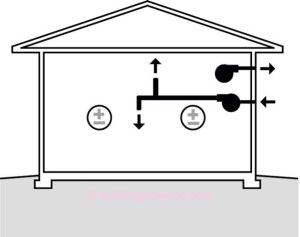
Conceptual diagram of a balanced ventilation system
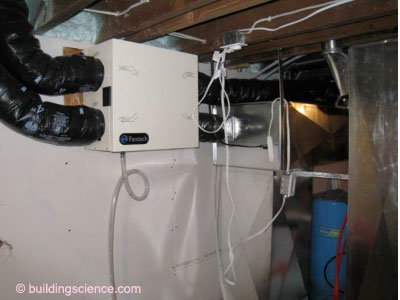
Heat recovery ventilator (HRV) installed in a basement, connected to a central air handler system
Single-Point HRV or ERV
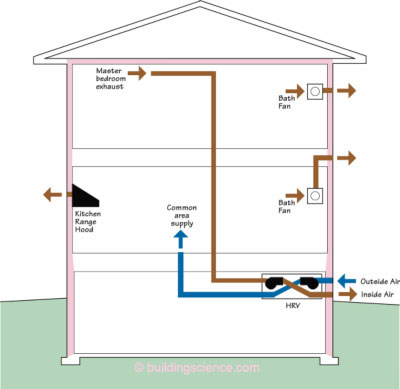
- A “simplified” approach is to exhaust from a single point, and to provide supply air from a single point. Exhausting from the master bedroom pulls ventilation air back to this room, without causing cool or warm air complaints in the bedroom.
- This system does not achieve whole-house distribution of ventilation air on its own. However, it is a low-cost method to install an HRV/ERV in houses without a central air handler (e.g., mini- or multi-split, radiator, or radiant floor space conditioning).
- Local exhaust fans are still required in kitchens and bathrooms, unless the exhaust is being drawn from one of these locations. However, exhausting a cooking area through an HRV/ERV is not recommended, due to UL certified fan requirements and risk of fouling the heat exchanger core.
- Pros: Ventilation air comes directly from outside and can be filtered, simple controls and low operating costs (no electrical interlock with central air handling system), limited ducting reduces first costs
- Cons: Does not achieve whole-house distribution or mixing
Multi-Point HRV or ERV (Fully Ducted)
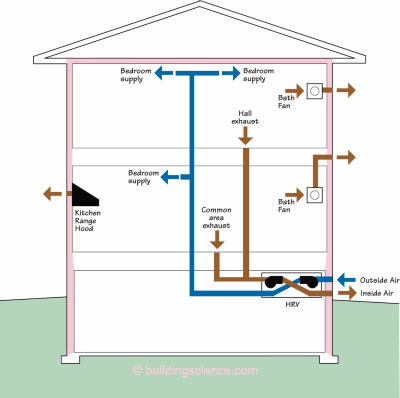
- A fully ducted HRV/ERV system is best practice: it is the most efficient and effective option. However, it has by far the highest installed cost. This system configuration shown above provides an even distribution of outside ventilation air to bedrooms first, where people spend the most continuous time in a single room (sleeping, with door closed).
- The best multi-point balanced ventilation systems typically supply fresh ventilation air directly to bedrooms and main living areas, and exhaust air from bathrooms, toilet rooms, general kitchen area, and possibly other pollutant source rooms such as laundries. The configuration shown above exhausts from the common space, and supplies to the bedrooms. Alternately, this system could exhaust from bedrooms and supply to common space.
- Local exhaust fans are still required in kitchens and bathrooms, unless the exhaust is being drawn from one of these locations. However, exhausting a cooking area through an HRV/ERV is not recommended, due to UL certified fan requirements and risk of fouling the heat exchanger core.
- If bedroom supplies are used, the register must be carefully placed to avoid “dumping” cool wintertime ventilation air directly on a sedentary or sleeping person.
- This configuration can be used where there is no central air handler system (e.g., mini- or multi-split, radiator, or radiant floor space conditioning).
- Pros: Best overall system. Ventilation air comes directly from outside and can be filtered, achieves whole-house distribution, simple controls, low operating costs
- Cons: Highest first cost (ducting required throughout house)
Multi-Point HRV or ERV with Partial Connection to Central Air Handler
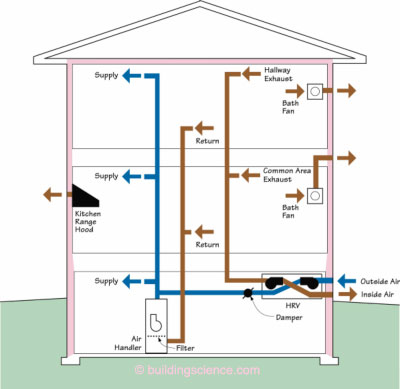
- This option draws exhaust air from the common areas and supplies outside air to the central air handler’s supply trunk. The ventilation air is then distributed throughout the house via the supply ductwork system.
- Periodic operation of the air handler fan provides whole-house mixing for distribution of ventilation air. This is accomplished with a fan cycling controller on the air handler. The controller should be set to turn the central system fan on a minimum of 10 minutes per hour (e.g. 50 off, 10 on).
- In humid climates, the air handler fan must operate whenever the HRV operates (i.e., an “interlock” is required), to avoid condensation risks in the supply trunk.
- BSC recommends against continuous operation of the air handler, due to excess energy use of the air handler fan, and the risk of re-evaporation of moisture off the cooling coil in any climate with latent loads. Use of a high efficiency variable speed (electronically commutated motor/ECM) air handler at low speed minimizes the energy penalty for mixing.
- A motorized damper is installed on the supply duct, which is opened when the HRV/ERV is running, and closed to prevent duct leakage during HVAC runtime.
- Differing air flows through the HRV/ERV can occur due to pressures created by the central air handler in the trunks. The dueling pressures can significantly reduce ventilation effectiveness.
- This system can also be set up to draw from bathrooms instead of hallways (thus eliminating bathroom exhaust fans). However, minimum bathroom exhaust flow rates must be met, and controls will be more complicated.
- Local exhaust fans are still required in kitchens and bathrooms, unless the exhaust is being drawn from one of these locations. However, exhausting a cooking area through an HRV/ERV is not recommended, due to UL certified fan requirements and risk of fouling the heat exchanger core.
- Pros: Ventilation air comes directly from outside and can be filtered, achieves whole-house distribution, moderate first cost (for HRV/ERV system)
- Cons: Cannot be used in a house lacking a central air handling system, interconnected controls and lockouts required, moderate operating costs, trunk pressure effects on air flows
Multi-Point HRV or ERV with Full Connection to Central Air Handler
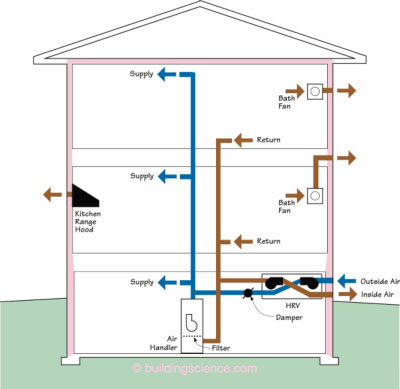
- This option draws exhaust air from the central air handler’s return trunk, and supplies outside air to the supply trunk. The ventilation air is then distributed throughout the house via the supply ductwork system
- Similar to the “partial connection” system, periodic mixing (fan cycling), central air handler interlock, and a motorized damper on the supply (outside air) duct are required. Also, “dueling” pressures may cause flow imbalances.
- This system can also be set up with supply and exhaust connections both to the air handler’s return trunk. The supply connection must be located a minimum of three feet downstream of the exhaust connection. This configuration is sometimes specified to avoid any condensation risks in the supply trunk. However, as a result, the interlock is required in all climates (otherwise, distribution air is “short circuited” in the return duct). In addition, the motorized damper is critical: otherwise, air handler operation will pull outside air “passively” through the HRV/ERV, overventilating the house.
- Local exhaust fans are still required in kitchens and bathrooms, unless the exhaust is being drawn from one of these locations. However, exhausting a cooking area through an HRV/ERV is not recommended, due to UL certified fan requirements and risk of fouling the heat exchanger core.
- Pros: Ventilation air comes directly from outside and can be filtered, achieves whole-house distribution, moderate first cost (for HRV/ERV system).
- Cons: Cannot be used in a house lacking a central air handling system, interconnected controls and lockouts required, moderate operating costs, trunk pressure effects on air flows. Commonly vulnerable to control problems resulting in ineffective ventilation, especially with both supply/exhaust connected to air handler return duct
Choosing Between HRVs and ERVs
A common question is which system to install: an ERV or an HRV? (i.e., whether or not to recover moisture from the exhaust air)
Manufacturers typically recommend choosing based on climate: HRVs are recommended in cold (heating-dominated) or dry climates, and ERVs in humid climates.
In humid climates, an ERV reduces the amount of moisture brought in along with outdoor air. However, ERVs do not dehumidify or “dry out” the interior in the summer, nor do they cool the interior. Where humidity is a problem, separate supplemental dehumidification is necessary (see “Information Sheet 620): Supplemental Humidity Control”.
The fact that ERVs recover moisture being sent out of the house can be a problem or an advantage—for instance:
- In a cold climate, an ERV in a small tight house with high occupancy might not remove enough moisture in wintertime. This would be evidenced as high interior humidity, window fogging, and possibly condensation inside wall cavities (see “RR-0203: Relative Humidity” for recommended RH levels).
- However, in that same climate, using an HRV on a large leaky house with low occupancy could result in uncomfortably low interior humidity levels. This would be made worse if an excessively high ventilation rate were used (e.g., 150 CFM continuous rate).
Using an HRV/ERV as a Bathroom Exhaust
There are several points to be noted if you plan to use the HRV or ERV to replace bathroom exhaust fans (thus reducing first costs):
- A set of controls is required at each bathroom, to turn the HRV/ERV on (or bring it up to high speed) to exhaust bathroom pollutants. Most manufacturers sell a “remote” wall switch that connects to the main HRV/ERV controller, and allows pushbutton 20/40/60 minute runtime, or a similar function.
- There can be a significant length of ductwork attached to the HRV to reach bathrooms. Therefore, it is important to design the duct system for adequate flow at each bathroom. For instance, ASHRAE Standard 62.2, and the LEED and Challenge Home programs all call for a minimum of 50 CFM for intermittent bathroom exhaust. If this amount is not drawn, the house does not meet program requirements.
- If there is a remote bathroom far from the HRV/ERV, it might be more sensible to ventilate that bathroom with its own exhaust fan, instead of using extensive ductwork (which could result in insufficient airflows).
- Ventilating bathrooms at a rate of 20 CFM continuously is another option permitted by code. However, with typical residential bathroom use, this results in more ventilation (and more energy use) than intermittent exhausts.
- In cold climates, the HRV/ERV must be set up to handle condensation of moisture-laden bathroom air (e.g., HRV with condensate drain, defrost).
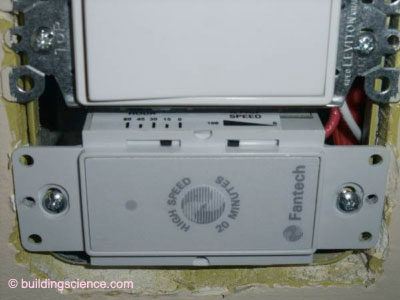
HRV controller, wired as wall switch in bathroom. Pressing the control will turn on the HRV at full speed for 20 minutes, to exhaust the bathroom. In addition, the HRV can be set to run on a timed cycle (a certain number of minutes each hour, 0-60), at a selectable speed (0-100%)
Suggestions for Further Research:
Rudd, Armin; Ventilation Guide, Building Science Press, 2011 Revision.
“RR-0203: Relative Humidity" www.buildingscience.com.
Information Sheet 620: “Supplemental Humidity Control” www.buildingscience.com
